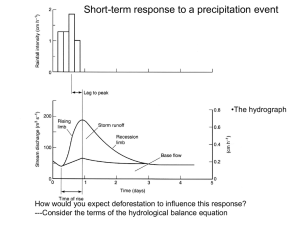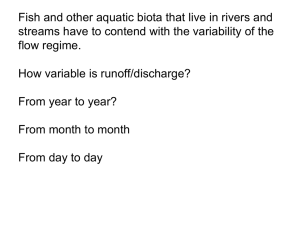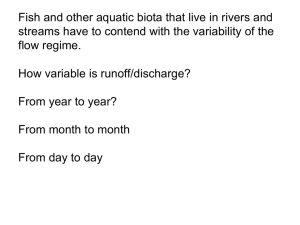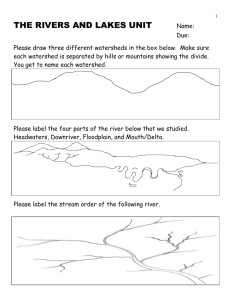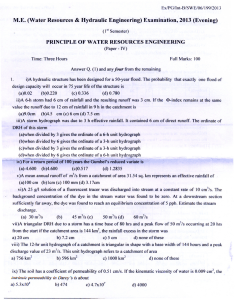Before Ottawa R dams After Ottawa R dams River Management can significantly
advertisement
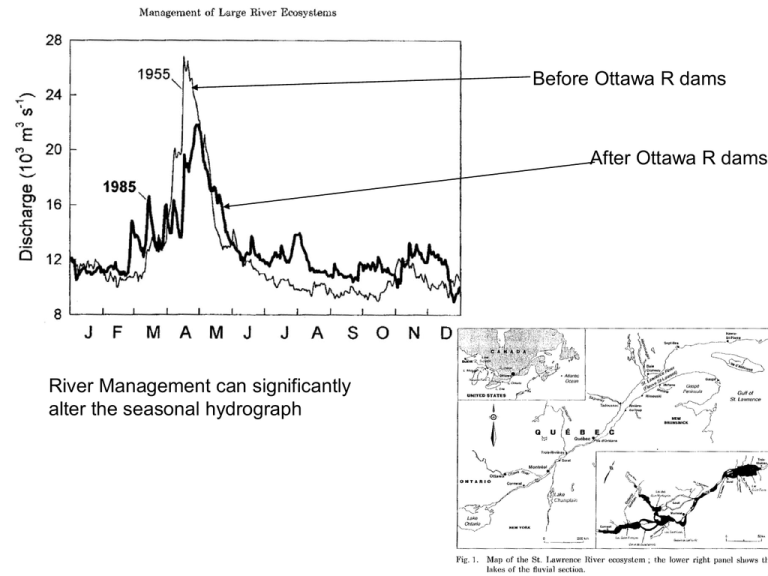
Before Ottawa R dams After Ottawa R dams River Management can significantly alter the seasonal hydrograph St.Lawrence River Flood Plain at Lac St. Pierre—has rarely been flooded since the late fifties—What effect might this have on the river? Short-term response to a precipitation event •The hydrograph How would you expect deforestation to influence this response? ---Consider the terms of the hydrological balance equation Human activities can markedly influence the shape of the hydrograph Deforestation •reduces the lag time •raises the peak • reduces the base flow How does deforestation affect the hydrological balance [P-E]DA – DS/Dt Fig 5-2 in your text We can explain the effects of deforestation on the hydrograph in terms of the hydrological balance, mainly in terms of changes in Evaporation and storage. Evaporation directly from the soil surface increases when plant cover is reduced, but usually transpiration from plant leaves is decreased more than surface evaporation increases. •leads to increased runoff—more area under the hydrograph curve Storage is reduced—water stored in plant tissues is removed, and the water holding capacity of soils is reduced by the death of roots. •Thus less of the water from the precipation event goes into recharging storage pools (DS is less), & more water enters the stream directly, reducing the lag time on the rising limb, and giving a higher and sharper peak in the deforested watershed. •Recession will also be faster and base flow lower in the deforested watershed since there will be less storage to sustain the stream flow after the rain stops. Biological Impacts that generally occur when watersheds are hydrologically disturbed by deforestation Scouring—increased flashiness of the hydrograph can scour and shift gravels. Siltation—shortening of hydrological lag time (usually associated with increased overland flow vs percolation--influx of fine particulate matter to streams. •plug up interstitial spaces in gravels & reduce water percolation and oxygen supply to interstitial benthic organisms & fish eggs in the gravels. •Siltation + increased dissolved organic material can reduce light penetration Nutrient enrichment—hydrological changes usually also increase the influx of Nitrogen & Phosphorus to the stream leading to increased algal growth on the substrate. Increased temperature & illumination—reduced forest cover, depending on how near to the stream bank trees are cut, can increase light penetration, warming the stream & changing the composition of benthic communities, by reducing survival of cold-water species. •increased illumination can also contribute to increased benthic algal growth on rocks. Patterns in stream flow and how they generate habitat diversity in streams •Annual discharge patterns—floodplain habitats •Stream meander—pool/riffle alternations •Stream channel changes over time—oxbow lakes, braided streams Flood plains depend on seasonal variability in river discharge Flood plain habitats greatly increase biodiversity in river systems. They contribute mostly temporary wetlands, but some remain as permanent because of groundwater inputs. •Important for •Waterfowl, mammals, amphibians, fish, aquatic insects, molluscs etc. •Most of the species found in flood plain wetlands would be lost from the river if the floodplain were not allowed to be flooded regularly. River flood plains often undergo extensive urban development Oxbow lake and the Chippewa River. Eau Claire, Wisconsin. http://www.uoregon.edu/~millerm/meander.html Many are also strongly impacted by agriculture Meander pattern of the Sacramento River, CA, note old abandoned channels and oxbows, and the encroachment of agriculture on the river channel. http://www.uoregon.edu/~millerm/meander.html Green River, Wyoming Such restoration can involve breaching of levees and removal of dams with the aim of.re-establishing natural floodplain vegetation and habitat http://vernalfishandwildlife.fws.gov/vernalfloodplain.jpg
